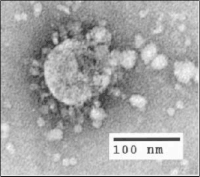
Photo from wikipedia
To assess changes in SARS-CoV-2 spike binding antibody prevalence in the Dominican Republic and implications for immunologic protection against variants of concern, we prospectively enrolled 2,300 patients with undifferentiated febrile… Click to show full abstract
To assess changes in SARS-CoV-2 spike binding antibody prevalence in the Dominican Republic and implications for immunologic protection against variants of concern, we prospectively enrolled 2,300 patients with undifferentiated febrile illnesses in a study during March 2021–August 2022. We tested serum samples for spike antibodies and tested nasopharyngeal samples for acute SARS-CoV-2 infection using a reverse transcription PCR nucleic acid amplification test. Geometric mean spike antibody titers increased from 6.6 (95% CI 5.1–8.7) binding antibody units (BAU)/mL during March–June 2021 to 1,332 (95% CI 1,055–1,682) BAU/mL during May–August 2022. Multivariable binomial odds ratios for acute infection were 0.55 (95% CI 0.40–0.74), 0.38 (95% CI 0.27–0.55), and 0.27 (95% CI 0.18–0.40) for the second, third, and fourth versus the first anti-spike quartile; findings were similar by viral strain. Combining serologic and virologic screening might enable monitoring of discrete population immunologic markers and their implications for emergent variant transmission.
Journal Title: Emerging Infectious Diseases
Year Published: 2023
Link to full text (if available)
Share on Social Media: Sign Up to like & get
recommendations!